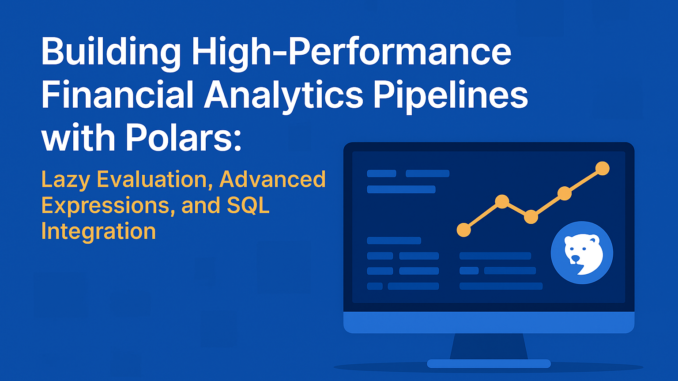
In this tutorial, we delve into building an advanced data analytics pipeline using Polars, a lightning-fast DataFrame library designed for optimal performance and scalability. Our goal is to demonstrate how we can utilize Polars’ lazy evaluation, complex expressions, window functions, and SQL interface to process large-scale financial datasets efficiently. We begin by generating a synthetic financial time series dataset and move step-by-step through an end-to-end pipeline, from feature engineering and rolling statistics to multi-dimensional analysis and ranking. Throughout, we demonstrate how Polars empowers us to write expressive and performant data transformations, all while maintaining low memory usage and ensuring fast execution.
We begin by importing the essential libraries, including Polars for high-performance DataFrame operations and NumPy for generating synthetic data. To ensure compatibility, we add a fallback installation step for Polars in case it isn’t already installed. With the setup ready, we signal the start of our advanced analytics pipeline.
n_records = 100000
dates = [datetime(2020, 1, 1) + timedelta(days=i//100) for i in range(n_records)]
tickers = np.random.choice([‘AAPL’, ‘GOOGL’, ‘MSFT’, ‘TSLA’, ‘AMZN’], n_records)
# Create complex synthetic dataset
data = {
‘timestamp’: dates,
‘ticker’: tickers,
‘price’: np.random.lognormal(4, 0.3, n_records),
‘volume’: np.random.exponential(1000000, n_records).astype(int),
‘bid_ask_spread’: np.random.exponential(0.01, n_records),
‘market_cap’: np.random.lognormal(25, 1, n_records),
‘sector’: np.random.choice([‘Tech’, ‘Finance’, ‘Healthcare’, ‘Energy’], n_records)
}
print(f”📊 Generated {n_records:,} synthetic financial records”)
We generate a rich, synthetic financial dataset with 100,000 records using NumPy, simulating daily stock data for major tickers such as AAPL and TSLA. Each entry includes key market features such as price, volume, bid-ask spread, market cap, and sector. This provides a realistic foundation for demonstrating advanced Polars analytics on a time-series dataset.
result = (
lf
.with_columns([
pl.col(‘timestamp’).dt.year().alias(‘year’),
pl.col(‘timestamp’).dt.month().alias(‘month’),
pl.col(‘timestamp’).dt.weekday().alias(‘weekday’),
pl.col(‘timestamp’).dt.quarter().alias(‘quarter’)
])
.with_columns([
pl.col(‘price’).rolling_mean(20).over(‘ticker’).alias(‘sma_20’),
pl.col(‘price’).rolling_std(20).over(‘ticker’).alias(‘volatility_20’),
pl.col(‘price’).ewm_mean(span=12).over(‘ticker’).alias(’ema_12′),
pl.col(‘price’).diff().alias(‘price_diff’),
(pl.col(‘volume’) * pl.col(‘price’)).alias(‘dollar_volume’)
])
.with_columns([
pl.col(‘price_diff’).clip(0, None).rolling_mean(14).over(‘ticker’).alias(‘rsi_up’),
pl.col(‘price_diff’).abs().rolling_mean(14).over(‘ticker’).alias(‘rsi_down’),
(pl.col(‘price’) – pl.col(‘sma_20’)).alias(‘bb_position’)
])
.with_columns([
(100 – (100 / (1 + pl.col(‘rsi_up’) / pl.col(‘rsi_down’)))).alias(‘rsi’)
])
.filter(
(pl.col(‘price’) > 10) &
(pl.col(‘volume’) > 100000) &
(pl.col(‘sma_20’).is_not_null())
)
.group_by([‘ticker’, ‘year’, ‘quarter’])
.agg([
pl.col(‘price’).mean().alias(‘avg_price’),
pl.col(‘price’).std().alias(‘price_volatility’),
pl.col(‘price’).min().alias(‘min_price’),
pl.col(‘price’).max().alias(‘max_price’),
pl.col(‘price’).quantile(0.5).alias(‘median_price’),
pl.col(‘volume’).sum().alias(‘total_volume’),
pl.col(‘dollar_volume’).sum().alias(‘total_dollar_volume’),
pl.col(‘rsi’).filter(pl.col(‘rsi’).is_not_null()).mean().alias(‘avg_rsi’),
pl.col(‘volatility_20’).mean().alias(‘avg_volatility’),
pl.col(‘bb_position’).std().alias(‘bollinger_deviation’),
pl.len().alias(‘trading_days’),
pl.col(‘sector’).n_unique().alias(‘sectors_count’),
(pl.col(‘price’) > pl.col(‘sma_20’)).mean().alias(‘above_sma_ratio’),
((pl.col(‘price’).max() – pl.col(‘price’).min()) / pl.col(‘price’).min())
.alias(‘price_range_pct’)
])
.with_columns([
pl.col(‘total_dollar_volume’).rank(method=’ordinal’, descending=True).alias(‘volume_rank’),
pl.col(‘price_volatility’).rank(method=’ordinal’, descending=True).alias(‘volatility_rank’)
])
.filter(pl.col(‘trading_days’) >= 10)
.sort([‘ticker’, ‘year’, ‘quarter’])
)
We load our synthetic dataset into a Polars LazyFrame to enable deferred execution, allowing us to chain complex transformations efficiently. From there, we enrich the data with time-based features and apply advanced technical indicators, such as moving averages, RSI, and Bollinger bands, using window and rolling functions. We then perform grouped aggregations by ticker, year, and quarter to extract key financial statistics and indicators. Finally, we rank the results based on volume and volatility, filter out under-traded segments, and sort the data for intuitive exploration, all while leveraging Polars’ powerful lazy evaluation engine to its full advantage.
print(f”\n📈 Analysis Results: {df.height:,} aggregated records”)
print(“\nTop 10 High-Volume Quarters:”)
print(df.sort(‘total_dollar_volume’, descending=True).head(10).to_pandas())
print(“\n🔍 Advanced Analytics:”)
pivot_analysis = (
df.group_by(‘ticker’)
.agg([
pl.col(‘avg_price’).mean().alias(‘overall_avg_price’),
pl.col(‘price_volatility’).mean().alias(‘overall_volatility’),
pl.col(‘total_dollar_volume’).sum().alias(‘lifetime_volume’),
pl.col(‘above_sma_ratio’).mean().alias(‘momentum_score’),
pl.col(‘price_range_pct’).mean().alias(‘avg_range_pct’)
])
.with_columns([
(pl.col(‘overall_avg_price’) / pl.col(‘overall_volatility’)).alias(‘risk_adj_score’),
(pl.col(‘momentum_score’) * 0.4 +
pl.col(‘avg_range_pct’) * 0.3 +
(pl.col(‘lifetime_volume’) / pl.col(‘lifetime_volume’).max()) * 0.3)
.alias(‘composite_score’)
])
.sort(‘composite_score’, descending=True)
)
print(“\n🏆 Ticker Performance Ranking:”)
print(pivot_analysis.to_pandas())
Once our lazy pipeline is complete, we collect the results into a DataFrame and immediately review the top 10 quarters based on total dollar volume. This helps us identify periods of intense trading activity. We then take our analysis a step further by grouping the data by ticker to compute higher-level insights, such as lifetime trading volume, average price volatility, and a custom composite score. This multi-dimensional summary helps us compare stocks not just by raw volume, but also by momentum and risk-adjusted performance, unlocking deeper insights into overall ticker behavior.
pl.Config.set_tbl_rows(5)
sql_result = pl.sql(“””
SELECT
ticker,
AVG(avg_price) as mean_price,
STDDEV(price_volatility) as volatility_consistency,
SUM(total_dollar_volume) as total_volume,
COUNT(*) as quarters_tracked
FROM df
WHERE year >= 2021
GROUP BY ticker
ORDER BY total_volume DESC
“””, eager=True)
print(sql_result)
print(f”\n⚡ Performance Metrics:”)
print(f” • Lazy evaluation optimizations applied”)
print(f” • {n_records:,} records processed efficiently”)
print(f” • Memory-efficient columnar operations”)
print(f” • Zero-copy operations where possible”)
print(f”\n💾 Export Options:”)
print(” • Parquet (high compression): df.write_parquet(‘data.parquet’)”)
print(” • Delta Lake: df.write_delta(‘delta_table’)”)
print(” • JSON streaming: df.write_ndjson(‘data.jsonl’)”)
print(” • Apache Arrow: df.to_arrow()”)
print(“\n✅ Advanced Polars pipeline completed successfully!”)
print(“🎯 Demonstrated: Lazy evaluation, complex expressions, window functions,”)
print(” SQL interface, advanced aggregations, and high-performance analytics”)
We wrap up the pipeline by showcasing Polars’ elegant SQL interface, running an aggregate query to analyze post-2021 ticker performance with familiar SQL syntax. This hybrid capability enables us to blend expressive Polars transformations with declarative SQL queries seamlessly. To highlight its efficiency, we print key performance metrics, emphasizing lazy evaluation, memory efficiency, and zero-copy execution. Finally, we demonstrate how easily we can export results in various formats, such as Parquet, Arrow, and JSONL, making this pipeline both powerful and production-ready. With that, we complete a full-circle, high-performance analytics workflow using Polars.
In conclusion, we’ve seen firsthand how Polars’ lazy API can optimize complex analytics workflows that would otherwise be sluggish in traditional tools. We’ve developed a comprehensive financial analysis pipeline, spanning from raw data ingestion to rolling indicators, grouped aggregations, and advanced scoring, all executed with blazing speed. Not only that, but we also tapped into Polars’ powerful SQL interface to run familiar queries seamlessly over our DataFrames. This dual ability to write both functional-style expressions and SQL makes Polars an incredibly flexible tool for any data scientist.
Check out the Paper. All credit for this research goes to the researchers of this project. Also, feel free to follow us on Twitter and don’t forget to join our 100k+ ML SubReddit and Subscribe to our Newsletter.
Sana Hassan, a consulting intern at Marktechpost and dual-degree student at IIT Madras, is passionate about applying technology and AI to address real-world challenges. With a keen interest in solving practical problems, he brings a fresh perspective to the intersection of AI and real-life solutions.






Be the first to comment